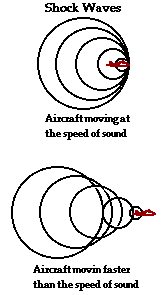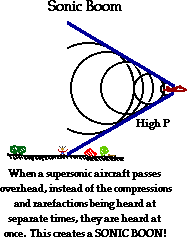Sound Barrier
Sound Barrier
Sound Barrier is a common term referring to the unusual amounts of drag in a fluid when an object approaches the speed of sound, which is about 1125 ft/s or 767 mph in dry air. First observed during World War II, the sound barrier doesn't exist as a physical limitation but rather represents the difficulty at which objects near the speed of sound experience when trying to accelerate further. The point at which the object does exceed this threshold, a shock wave is produced. The faster the object, the more conical the shock wave.

A common more easily understood example is that of a boat moving through water. The slow boat creates waves both behind and in front of it as the waves propagate faster than the boat can move. However once the boat starts moving faster than the waves can propagate, a wake is formed. Akin to the boat metaphor, an airplane moving through air creates sound waves and the resultant "wake" that is formed when moving supersonic speeds is called a sonic boom.
Shock Waves
These are regions of increased air pressure and temperature that are produced by any object moving through air and the most common example of a shock wave is the sonic boom.
Sonic Boom
The sonic boom is heard once the object passes the speed of sound. It is the result of all the compressible regions or high pressure regions in a wave front reaching the observer all at the same time instead of the usual delayed observed in the Doppler effect.

==
Examples
Connectedness
- The Sound Barrier is a common problem that many commercial vehicles are trying to overcome. As a mechanical engineer, it is my hope that I would do work in improving the efficiency of airplanes and vehicles in moving in supersonic speeds.
History
See also
Are there related topics or categories in this wiki resource for the curious reader to explore? How does this topic fit into that context?
Further reading
Books, Articles or other print media on this topic
External links
Internet resources on this topic
References
http://science.howstuffworks.com/question73.htm http://www.physicscentral.com/explore/action/shockwaves.cfm http://www.physicsclassroom.com/class/sound/Lesson-3/The-Doppler-Effect-and-Shock-Waves https://en.wikipedia.org/wiki/Swept_wing https://en.wikipedia.org/wiki/Area_rule http://mathforum.org/library/drmath/view/56298.html